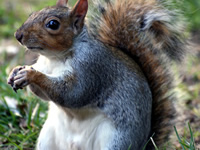Squirrel
[audio:squirrel.mp3|titles=Squirrel Sounds]

Peak Nuisance Period: SEPTEMBER – FEBRUARY; denning activity MARCH – MAY; when females seek places to raise their young
Common Nuisance Situations:
- They den in attics, walls, sheds, barns, and chimneys, annoying people with their noise and odors.
- Squirrels usually gain access via overhanging branches, power lines, or by climbing up the siding. They may fall into chimney and furnace flues, thus gaining entrance to the basement or interior of the house.
- Their nest materials might block a vent, causing a fire hazard.
- They constantly need to chew. They will look to knaw on and scratch wires (another fire hazard) and also damage attic vents, eaves, screens, bird feeders, siding, insulation, household goods, and the tubing used for maple syrup production.
- They run along power lines and sometimes short out transformers.
- Squirrels also eat garden, field, and orchard crops; bird seed; and newly planted vegetable seeds. They’ll strip the bark from trees, especially fruit trees and cedar.
- Disease risks: mange, cat scratch disease, typhus, rabies (rarely).
Animal Characteristics
Description: There are two types of squirrels most commonly found to become major nuisances in Northern New Jersey and New York, the Grey Squirrel and the Southern Flying Squirrel.
Grey Squirrel: Gray above, white below; in summer, head, legs, and sides washed with tawny
brown. Eye ring buffy; tail long, bushy, grizzled blackish and white. All-black individuals occur locally, esp. in urban areas. Vocal; gives variety of chattering and clucking calls. Region’s most commonly seen mammal. Active by day all year round.
Southern Flying Squirrel: The Southern Flying Squirrel is the smallest squirrel in our area. Adults weight between 2 and 3 1/2 ounces. The dense, soft fur is grayish-brown above and a creamy white underneath. The eyes of the flying squirrel are exceptionally large in relation to its body size. At a glance the flying squirrel looks like it is ‘flying’, but in reality it glides from branch to branch. The most noticeable feature is the loose fold of skin which extends from the wrists of the forearm to the ankles of the hind legs. This fold of skin is stretched when the legs are extended to form a wing-like surface that allows the flying squirrel to glide from tree to tree. The tail is furred and flattened. They are nocturnal animals.
Diet: Eats nuts, buds, inner bark, fruit on ground and in trees.
Habitat: Broad leaf and mixed woods, towns.
Breeding: 2 periods of breeding, December to February and May to June. The gestation period is 44 days, the first litter is born February to March, the second one June to July. Typical litter size of 2 to 6 pups.
Mythbusters: N/A
